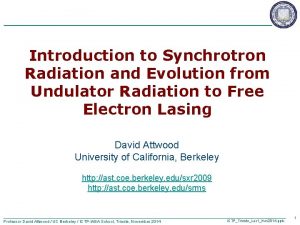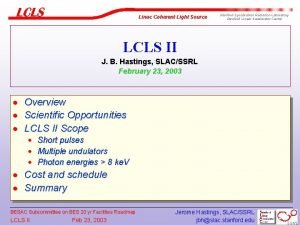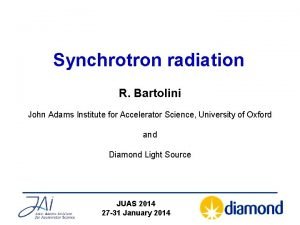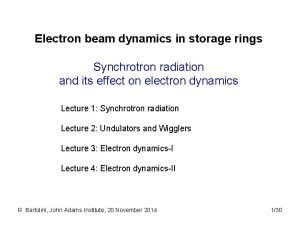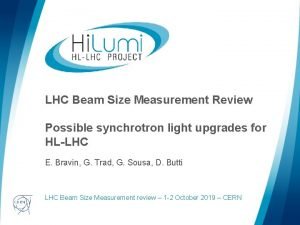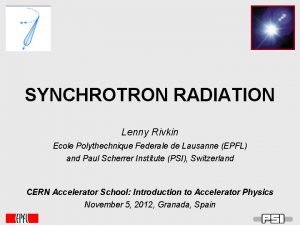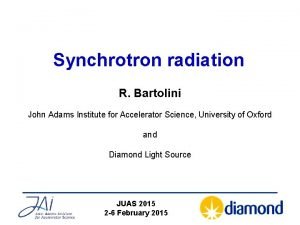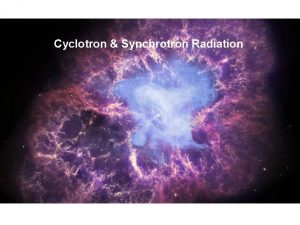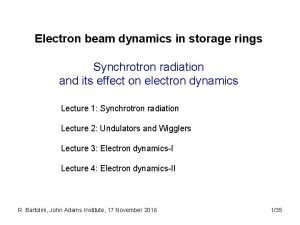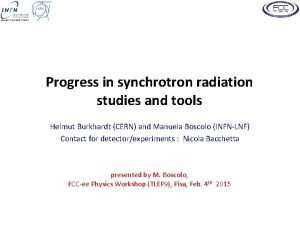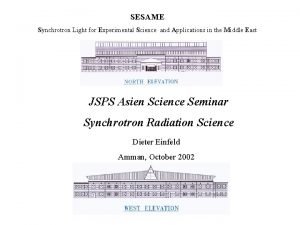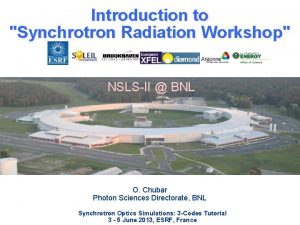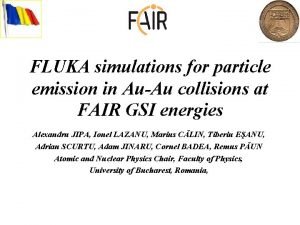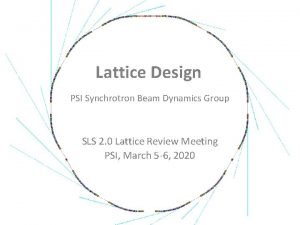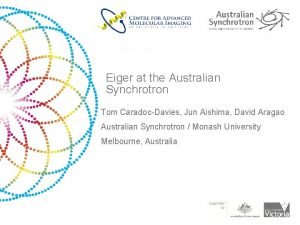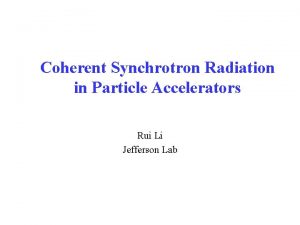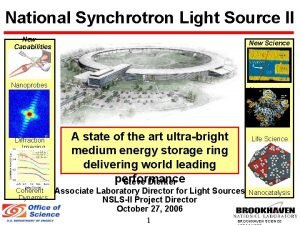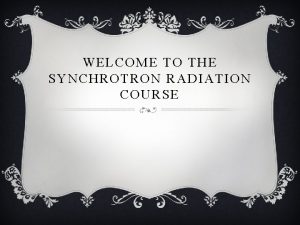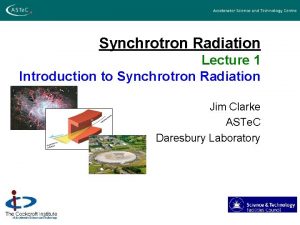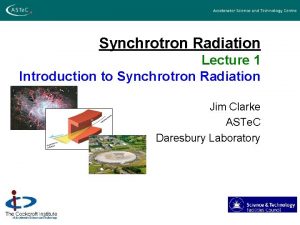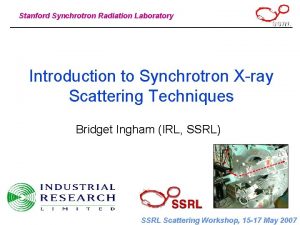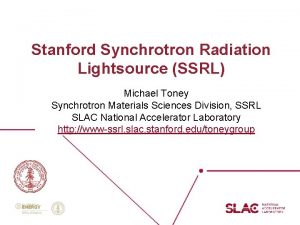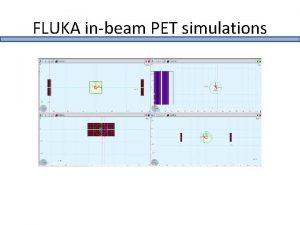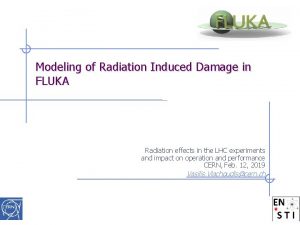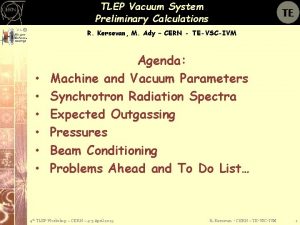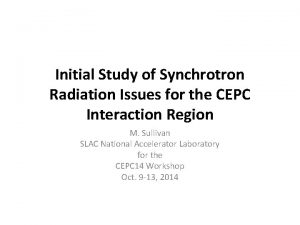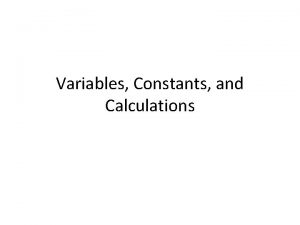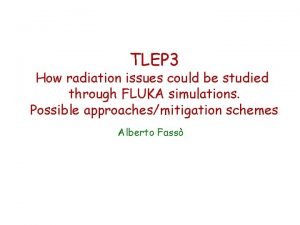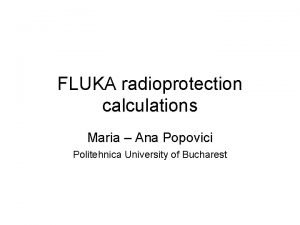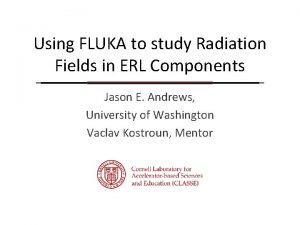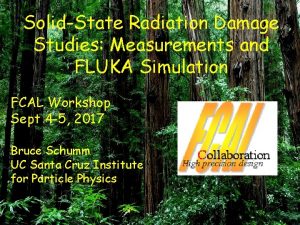Initial FLUKA calculations for synchrotron radiation at TLep


























- Slides: 26

Initial (FLUKA) calculations for synchrotron radiation at TLep April 4 th , 2013 F. Cerutti, A. Ferrari, L. Lari* *BE Dept.

Outline A few reminders about Synchrotron Radiation FLUKA implementation Some geometrical considerations Photon attenuation and spectra for TLep 1. 2. 3. 4. 1. 2. 5. 6. 2 Results Physical interpretation Photoneutrons Conclusions Alfredo Ferrari, Tlep workshop 4/4/2013

SR: generalities 3 Alfredo Ferrari, Tlep workshop 4/4/2013

SR: generalities Pb( , x) 3 x Al( , x) 4 Alfredo Ferrari, Tlep workshop 4/4/2013

FLUKA implementation of SR Sophisticated low energy photon transport including polarization effects for Compton (see next slide), photoelectric and coherent scattering, and full account for bound electron effects: already available in FLUKA since several years Ø New: dedicated “generic” source for SR radiation accounting for: Ø ü ü ü 5 Spectrum sampling Polarization as a function of emitted photon energy Angular distribution Arbitrary orientation emitting particle vs magnetic field Photon emission along arcs/helical paths Alfredo Ferrari, Tlep workshop 4/4/2013

Compton scattering: dynamics Klein-Nishina cross section (see for example Heitler, “The Quantum Theory of Radiation”): Let e be the polarization vector of the incident photon, and e’ that of the scattered one: Split into the two components, and || to e respectively (actually with e’ to the Important polarization effects plane (e, k’) , or contained in the plane (e, k’) ): breaking the azimuthal symmetry! k k’ e’ 6 Alfredo Ferrari, Tlep workshop e 4/4/2013

Tlep: parameters for the calculations �E = 175 Ge. V, R = 9000 m � Ecrit= 1. 32 Me. V, E=9. 2 Ge. V/turn, d. E/ds=1. 63 ke. V/cm � P = 9. 2 I[m. A] MW, d. P/ds=1. 6 I[m. A] W/cm � Simplified geometry, cylindrical Al beam pipe and (Pb) shielding � SR photons generated and tracked above 100 e. V (99. 999% of the total power), average energy of the photons <E>=430 ke. V (E>100 e. V) 7 A decrease of 15% in R (eg Holzer talk) a corresponding increase in E c , power, and likely a factor a few in photoneutron production Alfredo Ferrari, Tlep workshop 4/4/2013

Synchrotron. Radiation Interception ℓ ℓ dipole length ℓ totally escaping ( hitting downstream elements) for shorter dipoles Pb shielding in the interconnects ? For the time being: impact angle as for “curved” geometry (eg, very short magnets, or very long curved ones) Alfredo Ferrari, Tlep workshop 8 4/4/2013

Tlep Idealized geometry B 3 mrad q Vacuum pipe: round R = 4. 5 cm q Aluminum pipe: thickness = 0. 5 cm q Lead shielding: thickness = 5. 0 cm 9 Alfredo Ferrari, Tlep workshop Scoring surfaces 4/4/2013

How different is the attenuation vs the equivalent line-of-sight? 3 mrad incidence Radius or Depth sin(3 mrad) (cm) 10 Alfredo Ferrari, Tlep workshop 4/4/2013

Photon cross sections : Photoelectric dominated 11 Compton dominated Pair dominated Photoelectric Compton Pair dominated p. e. =photoelectric cross section; incoh=Compton cross section; coherent=Rayleigh cross section; nuc=photonuclear cross section; N=pair production cross section, nuclear field; e=pair production cross section, electron field Alfredo Ferrari, Tlep workshop 4/4/2013

Compton ang. distr. : examples 500 ke. V on Al 500 ke. V on Au blue = free electron green = binding with form factors red = binding with shells and orbital motion 12 Alfredo Ferrari, Tlep workshop 4/4/2013

The physical explanation The first scattering effect: after a Compton interaction the photon loses “memory” of the initial, grazing, incidence because of the much larger scattering angle 13 Alfredo Ferrari, Tlep workshop 4/4/2013

Photon fluence attenuation for 3 angles Vacuum As expected, after a few mm the memory of the initial incidence angle is lost Al Pb 14 Alfredo Ferrari, Tlep workshop 4/4/2013

Vacuum Photon fluence attenuation curves for 3 angles Al Pb 15 Alfredo Ferrari, Tlep workshop 4/4/2013

Al Kx lines 16 Pb Kx lines Alfredo Ferrari, Tlep workshop Photon spectra at various depths Annihilation 4/4/2013

Backscattered photon and electron spectra 17 Alfredo Ferrari, Tlep workshop 4/4/2013

Power attenuation: escaping energy as a function of radius 100% 1% Al Pb 18 Alfredo Ferrari, Tlep workshop 0. 1% 4/4/2013

Escaping energy vs fluence as a function of radius Remarks, after 5 cm of Pb: Ø Power and fluence are not yet exponentially attenuated Ø The escaping power is decreasing slower than the photon fluence Al Pb 19 Alfredo Ferrari, Tlep workshop 4/4/2013

Neutron spectra at various depths Neutron production: 1. 1 10 -10 n/cm/e, 7 105 n/s/cm/m. A Activity at saturation: 170 k. Bq/cm/m. A (mostly 203 Pbgs/m, 26 Alm, 205 Pbm) After 1 day: 5. 5 k. Bq/cm/m. A After 1 week: 800 Bq/cm/m. A (almost only 203 Pb) 20 Alfredo Ferrari, Tlep workshop 4/4/2013

Conclusions � SR calculations possible with full generality � Some minimal layout specs (dipole length, curved or straight, beam pipe radius) requiredin order to start devising a shielding strategy , maybe possible to interceptmost of SR at interconnections ? � Specs about the “tolerable” escaping power levels required as well � As expected the attenuation curve is insensitiveto the incidence angleand (unfortunately) far from naïve line-of-sight approximations � Photoneutronproduction and associated activation (relatively) minor, it will change steeply with Ec 21 Alfredo Ferrari, Tlep workshop 4/4/2013

Backup Slides 22 Alfredo Ferrari, Tlep workshop 4/4/2013

Photon spectra at various depths 23 Alfredo Ferrari, Tlep workshop 4/4/2013

Compton ang. distr. : examples II 50 ke. V on Au 5 ke. V on Au blue = free electron green = binding with form factors red = binding with shells and orbital motion Effects visible only at cos close to 1. The S(q, Z) approximation is still very good at 50 ke. V, 24 Alfredo Ferrari, Tlep workshop 4/4/2013

Compton profile: examples 500 ke. V on Al E’/E 500 ke. V on Au E’/E green = free electron blue = binding with form factors red = binding with shells and orbital motion Larger effect at very low energies, where, however, the dominant process is photoelectric. Visible: shell structure near E’=E, smearing from motion at low E’ 25 Alfredo Ferrari, Tlep workshop 4/4/2013

Compton profile: examples II 50 ke. V on Au E’/E 5 ke. V on Au E’/E green = free electron blue = binding with form factors red = binding with shells and orbital motion Larger effect at very low energies, where, however, the dominant process is photoelectric. Please note that the actual cross section goes down again at low energies!! Visible: shell structure near E’=E, smearing from motion at low E’ 26 Alfredo Ferrari, Tlep workshop 4/4/2013
 Timeslep
Timeslep Synchrotron radiation
Synchrotron radiation Linear accelerator stanford
Linear accelerator stanford Synchrotron radiation
Synchrotron radiation Synchrotron radiation
Synchrotron radiation Bsrtm
Bsrtm Bremsstrahlung radiation
Bremsstrahlung radiation Synchrotron radiation
Synchrotron radiation Cyclotron and synchrotron radiation
Cyclotron and synchrotron radiation Synchrotron radiation
Synchrotron radiation Synchrotron radiation
Synchrotron radiation Synchrotron radiation
Synchrotron radiation Synchrotron radiation workshop
Synchrotron radiation workshop Types of connections in steel structures
Types of connections in steel structures Remnant weisskopf code
Remnant weisskopf code Fluka course
Fluka course Fluka simulation
Fluka simulation Psi synchrotron
Psi synchrotron Synchrotron
Synchrotron Synchrotron
Synchrotron National synchrotron light source ii
National synchrotron light source ii Bästa kameran för astrofoto
Bästa kameran för astrofoto Ledarskapsteorier
Ledarskapsteorier Bat mitza
Bat mitza Sju för caesar
Sju för caesar Nyckelkompetenser för livslångt lärande
Nyckelkompetenser för livslångt lärande Mästar lärling modellen
Mästar lärling modellen

